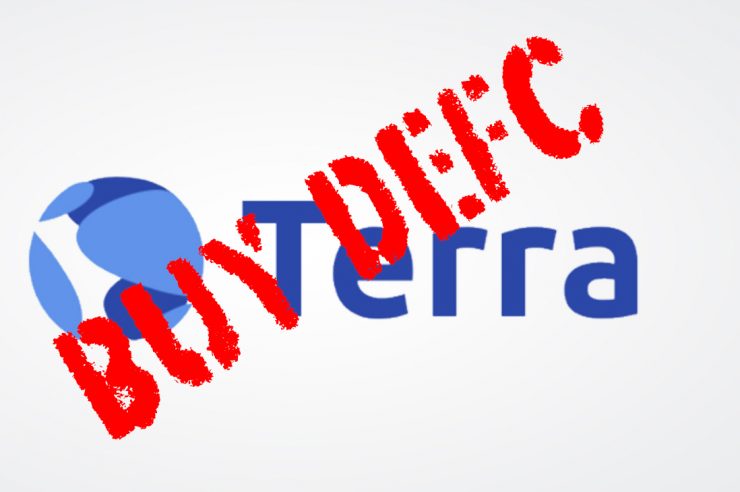Widely used DeFi coin TerraUSD (UST) has lost its 1:1 peg to the US dollar (USD) in spectacular fashion.
The UST stablecoin fell as low as $0.227 and is currently trading at $0.418, more than 50% off its peg. The longer the stablecoin fails to maintain its 1:1 USD peg, the more likely it is to totally collapse as confidence evaporates.
Up until recently UST was a favoured stablecoin, with its symbiotic relationships with Luna helping to propel higher the price of its arbitraging coin. 1 UST is designed to be at all times redeemable for $1 USD worth of Luna. The peg is maintained through a minting and burning mechanism.
But Luna is faring even worse than UST, currently down 97% from it’s all-time high of $119 at $0.89.
Now all eyes are on the deep-pocketed entrepreneur behind the algorithmic stablecoin, Do Kwon, and whether he can sustain a rescue effort.
On Tuesday it looked like a rescue might be able to succeed, with UST recovering to trade at 94 cents, but that hasn’t held as the market increasingly doubts the ability of Do Kwon to pull off his rescue.
News surfaced that UST’s backers connected to South Korea-based Terraform Labs, which issued the coins and the Luna Foundation Guard, were seeking to raise $1.5 billion to rescue UST. The fundraise was thought to be in the form of a loan denominated in Bitcoin and UST.
Can redesigned minting or $1.5 billion loan save TerraUSD?
However, if the latest tweet from Do Kwon is anything to go by, that gambit may have failed.
Now he has turned to trying to fix the minting mechanism which has patently failed to hold the peg. A number of changes to that mechanism intend to boost the minting capacity from $293 million to $1.2 billion.
Aside from its uses in DeFi, where it could be staked to earn interest and used as a store of value, the ecosystem was also geared towards e-commerce, with Daniel Chin’s connections as the founder and CEO of payments giant Chi Corporation and the deal put in place with a host of merchants across the Asia region.
But all that promise to revolutionise payments networks looks at risk today.
The disaster for UST was set in motion over the weekend when the stablecoin first slipped below its peg, initially only to 99c, but that was significant all the same. Following sustained selling pressure since then, the stablecoin proved itself to be anything but stable, placing a cloud over the entire algorithmic stablecoin sub-sector.
Unlike stablecoins such as Tether and USDC, algo stablecoins do not hold cash or cash equivalents as collateral.
Is the run on UST responsible for the crypto sell-off?
The sheer size of UST, with a market cap of $18.5 billion, and Do Kwon’s on-record commitments to buy as much as $10 billion worth of bitcoin to support UST, speaks to the systemic risk the stablecoin posed to the crypto sector.
Indeed, some argue that UST is responsible for the crypto market sell-off being as fierce as it has been, although the explanation for the sell-off is likely more connected to the pull back in risk assets generally, as seen in the stock market, with UST perhaps responsible for adding accelerant to proceedings rather than being the fundamental cause.
The drama with UST has led to market participants wondering which algo stablecoin might be next. FraxShare stablecoin, for example, is down 20% in the past 24 hours.
But there have been some rays of sunshine peeking out from the darkening storm clouds. Maker (MKR), the lending platform that locks ETH and mints the stablecoin Dai, is up 9% in the past 24 hours, at $1,360.
DeFi Coin (DEFC) is an alternative DeFi anchor currency that’s set to benefit
Alternatives to UST are likely to benefit. Stakers looking to earn interest from their UST holdings are likely today working out how and when to offload their not-so-stable stablecoins, with securing an income stream a less pressing concern.
UST had been attracting APRs of 19.5% paid by the dominant lending protocol on terra, Anchor, but that’s a far cry from the returns that can be earned by staking DEFC on DeFi Swap right now.
Even the 30-day staking period pays better than Anchor ever did, at 30% APR (bronze plan).
If you are happy to stake for 360 days then returns top 75% with the platinum plan available.
And as far as base currencies for trading pools goes, holding DEFC will be a much more profitable activity for liquidity providers, not to mention the fact that DEFC price has risen nearly 200% in the past seven days.
DeFi Lama data shows Luna TVL collapsing
According to DeFi Lama total value locked (TVL) for Terra Luna (LUNA) has dropped from $29 billion on 6th May to £3.2 billion, down 75% in the past 24 hours. Anchor (ANC) is down 70% in the past 24 hours to a TVL of $2.13 billion.
UST’s crash led to US Treasury Secretary Janet Yellen telling the Senate Banking, Housing and Urban Affairs Committee yesterday that the TerraUSD blow-up highlights the urgent need for regulation of the sector.
“A stablecoin known as TerraUSD experienced a run and had declined in value…I think that simply illustrates that this is a rapidly growing product and that there are risks to financial stability and we need a framework that’s appropriate.”
In other DEFC news, from today swap pairs in BNB/DEFC and LBLOCK/DEFC became active today on DeFi Swap.







Comments (No)